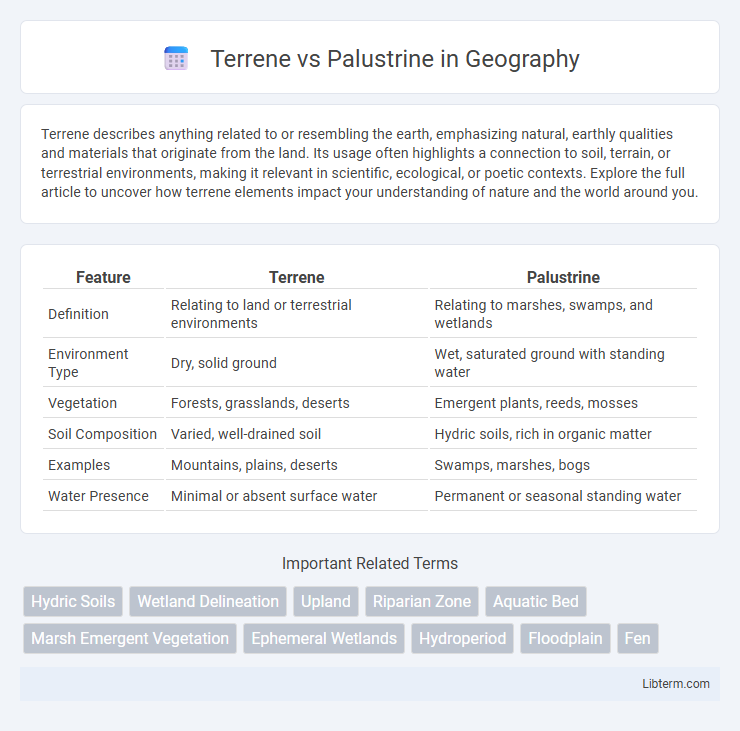Terrene describes anything related to or resembling the earth, emphasizing natural, earthly qualities and materials that originate from the land. Its usage often highlights a connection to soil, terrain, or terrestrial environments, making it relevant in scientific, ecological, or poetic contexts. Explore the full article to uncover how terrene elements impact your understanding of nature and the world around you.
Table of Comparison
| Feature | Terrene | Palustrine |
|---|---|---|
| Definition | Relating to land or terrestrial environments | Relating to marshes, swamps, and wetlands |
| Environment Type | Dry, solid ground | Wet, saturated ground with standing water |
| Vegetation | Forests, grasslands, deserts | Emergent plants, reeds, mosses |
| Soil Composition | Varied, well-drained soil | Hydric soils, rich in organic matter |
| Examples | Mountains, plains, deserts | Swamps, marshes, bogs |
| Water Presence | Minimal or absent surface water | Permanent or seasonal standing water |
Understanding Terrene and Palustrine: Definitions
Terrene environments refer to terrestrial habitats primarily characterized by land-based ecosystems such as forests, grasslands, and deserts. Palustrine areas are freshwater wetlands dominated by non-tidal vegetation, including marshes, swamps, and bogs, often found in depressions or floodplains. Understanding these definitions highlights the distinction between dry land ecosystems (terrene) and saturated, water-influenced habitats (palustrine), crucial for ecological classification and habitat conservation.
Key Characteristics of Terrene Ecosystems
Terrene ecosystems are characterized by their terrestrial habitats, predominantly featuring soils, varied vegetation, and non-aquatic fauna adapted to land environments. These ecosystems support diverse plant communities ranging from forests and grasslands to deserts, shaped by factors like climate, soil type, and topography. Unlike palustrine systems, terrene ecosystems lack persistent surface water, emphasizing the role of abiotic elements such as sunlight and atmospheric conditions in driving ecological processes.
Key Features of Palustrine Wetlands
Palustrine wetlands are characterized by their non-tidal, inland freshwater systems dominated by trees, shrubs, and persistent emergent vegetation, distinguishing them from terrene landscapes that are predominantly upland and dry. These wetlands often include marshes, swamps, and bogs, serving as critical habitats for diverse wildlife and supporting high levels of biodiversity. Palustrine wetlands play essential roles in water filtration, flood control, and carbon storage, contributing significantly to ecosystem services and environmental health.
Ecological Functions of Terrene Habitats
Terrene habitats play a critical role in maintaining terrestrial biodiversity by providing essential resources such as food, shelter, and breeding grounds for a wide range of species. These ecosystems contribute to carbon sequestration, mitigating climate change impacts through soil organic matter accumulation and plant biomass growth. Furthermore, terrene habitats regulate hydrological cycles by facilitating groundwater recharge, reducing surface runoff, and enhancing water quality through natural filtration processes.
Ecological Importance of Palustrine Systems
Palustrine systems, consisting primarily of freshwater wetlands such as marshes, swamps, and bogs, provide critical ecological functions including water filtration, flood control, and habitat support for diverse species. Unlike terrene ecosystems dominated by upland vegetation, palustrine wetlands serve as significant carbon sinks, mitigating climate change by storing large amounts of organic carbon in saturated soils. Their role in maintaining biodiversity and hydrological stability underscores their importance in sustaining healthy environmental systems.
Biodiversity Differences: Terrene vs Palustrine
Terrene ecosystems, such as forests and grasslands, support high biodiversity with diverse flora and fauna adapted to terrestrial conditions, including mammals, birds, insects, and many plant species. Palustrine systems, like wetlands and marshes, host unique aquatic and semi-aquatic species, including amphibians, waterfowl, and specialized aquatic plants, contributing to distinct ecological communities. The variation in water availability and habitat structure drives significant differences in species composition and ecological functions between terrene and palustrine environments.
Hydrological Processes in Terrene and Palustrine Areas
Terrene hydrological processes are characterized by surface runoff, infiltration, and groundwater recharge in upland or terrestrial environments with well-drained soils and variable vegetation cover. Palustrine areas, commonly wetlands, exhibit slow water movement, frequent saturation, and high water retention due to organic-rich soils and dense vegetation, influencing hydrological flow paths and nutrient cycling. The differences in these processes affect water storage, quality, and ecosystem functions in terrestrial versus palustrine landscapes.
Human Impacts on Terrene and Palustrine Environments
Human activities significantly alter terrene and palustrine environments through urbanization, agriculture, and pollution, leading to habitat fragmentation and loss of biodiversity. Terrene ecosystems often experience soil compaction and erosion from deforestation and land development, while palustrine wetlands face drainage, nutrient loading, and contamination that disrupt hydrological functions. Both environments suffer from anthropogenic pressures that reduce ecosystem services, emphasizing the need for integrated conservation strategies.
Conservation Strategies for Terrene and Palustrine Ecosystems
Conservation strategies for terrene ecosystems prioritize habitat restoration, invasive species management, and sustainable land-use practices to preserve biodiversity and ecosystem functions. Palustrine ecosystems demand targeted wetland protection, water quality monitoring, and hydrological regime maintenance to support aquatic species and maintain natural flooding cycles. Both ecosystems benefit from integrated landscape planning and community engagement to ensure long-term ecological resilience.
Future Trends and Research in Terrene and Palustrine Studies
Emerging research in terrene and palustrine studies emphasizes advanced remote sensing technologies and ecological modeling to predict habitat shifts under climate change scenarios. Future trends highlight the integration of multidisciplinary approaches combining hydrology, soil science, and biodiversity assessments to enhance conservation strategies. Innovations in automated monitoring systems and data analytics are expected to improve the accuracy of ecosystem health evaluations and resource management practices.
Terrene Infographic

 libterm.com
libterm.com